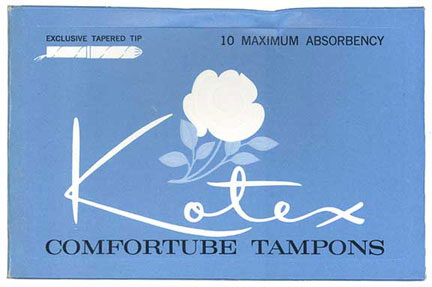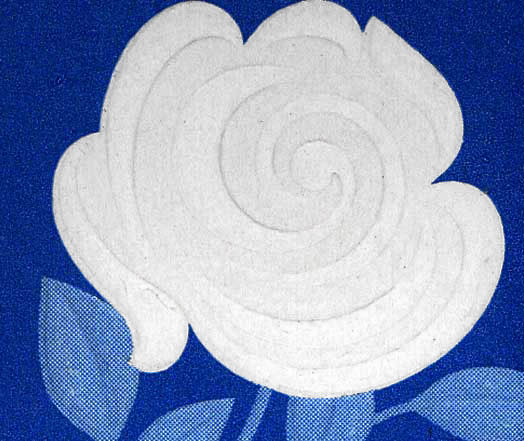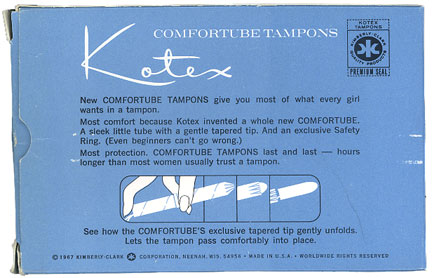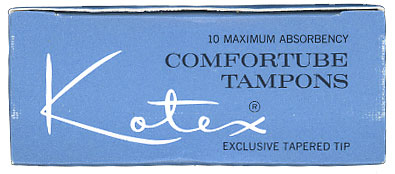Earlier Kotex tampons: Fibs (started 1930s)
and Nunap (early
1930s).
See more Kotex items: First ad
(1921; scroll to bottom of page) - ad 1928 (Sears and Roebuck
catalog) - Lee
Miller ads (first real person in a
menstrual hygiene ad, 1928) - Marjorie May's Twelfth
Birthday (booklet for girls, 1928,
Australian edition; there are many links
here to Kotex items) - Preparing for
Womanhood (1920s, booklet for girls;
Australian edition) - 1920s booklet in
Spanish showing disposal
method - box
from about 1969 - "Are you in the
know?" ads (Kotex) (1949)(1953)(1964)(booklet, 1956) -
See more ads on the Ads
for Teenagers main page


|

Kotex Comfortube menstrual
tampons, 1967, U.S.A.
Box with embossed
flower & tampon
|
As I wrote on the page for the 1960s Kotex
pad, most American woman want to
wind up smelling
like a rose, not
menstrual blood! But at least at
times in the past - and maybe
today in places - women allowed
others to smell and see her
menstrual blood as a sign of
fertility and to sexually
attract others, as
extraordinary this may seem to
most North Americans and Europeans
(and to me just a couple of years
ago). (The English feminist Selina
Cooper writes
(towards the bottom of the page)
about this among English girls in
a cotton mill around 1900, where straw covered
the floor to absorb their
escaping blood.) This
fact lends credence to my
suspicion that many or most women
in Europe and North America prior
to about 1900 bled into their
clothing - that is, they
did not use rags or tampons or
anything else to absorb and
conceal the blood. Times sure have
changed - why? Read more
about this.
See a cup-shaped
tulip advertising a
menstrual cup.
See the
Comfortube tampon.
|
 |
The box measures 5.37" x 3.5" x
1.37" (about 13.7 x 8.8 x 3.6 cm).
Embossed flower, enlarged, below,
and darkened to make the embossing
visible.
|
 |
 |
Back of box and details below.
|
 |
 |
 |
Above:
Sides are identical, as are the
ends (below).
|
 |
NEXT:
see the Comfortube tampon. See
the first major Kotex tampon
(1930s), Fibs,
and its possible early 1930s antecedents;
and a Kotex pad probably from the
1930s and
one from the early
1960s.
� 2006 Harry Finley. It is
illegal to reproduce or distribute
any of the
work on this Web site in any
manner or medium without written
permission
of the author. Please report
suspected violations to [email protected]
|
|